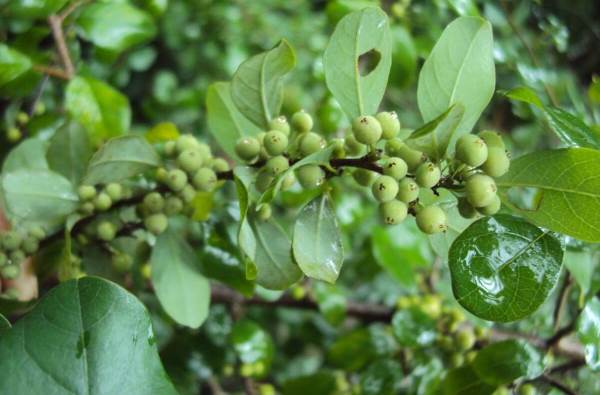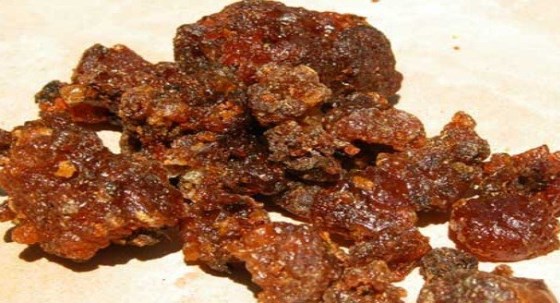A step by step guide for Guggul Cultivation, Planting:

Introduction of Guggul:
What is Guggulu? Guggulu is obtained from Indian Bdellium or Gum Guggul tree. It is an oleo gum ‘resin’ exuded by the plant during summer months (April to May in India). To obtain resin, circular incisions should be made on the main stem. Through these incisions, aromatic fluid exudes that quickly solidifies to form a golden brown or reddish brown agglomerate. The dried resin will have a bitter taste and a balsamic odor. This is being termed as “guggulu: and is used for medicinal purpose. Guggul is a shrub (small tree) which can reach a height of 12 feet with thin paper bark. Basically, it is grown for its medicinal properties. The Guggul tree branches are thorny and individual flowers are red to pink with 4 small petals. This plant may be found from the USA to Asia but is mostly found in north Indian regions especially Rajasthan, Gujarat, Maharashtra, and Karnataka. This plant is also found in Bangladesh and Pakistan. Guggul is cultivated in larger areas of Ajmer district of Rajasthan. The Guggul shrub defoliates in winter and a reserve for Guggul gum extraction is high during months of April to May. Guggul gum-resin is used in Ayurvedic medicines as a remedy to reduce cholesterol in the blood. This plant is also very useful in treating arthritis and obesity. Commercial cultivation of Guggul may increase every year as the demand for herbal medicine is increasing day by day.
Family Name of Guggul:
“Burseraceae”.
Botanical/Scientific Name of Guggul:- “Commiphora wightii (Arn.)”.
Genus of Guggul:
“Commiphora”.
Parts Used in Guggul:
Resin exuded by Guggul plant.
Health Benefits and Uses of Guggul:
Guggulu has excellent medicinal properties and used to treat many disorders.
- It improves digestion and appetite.
- It is useful in activating thyroid function.
- It is a useful drug to treat high cholesterol.
- It also helps eliminate and expel dead tissues, wastes, and toxins from the body.
- It breaks down the clot and prevents platelet aggregation.
- It fights obesity and stimulates weight loss. Due to this property, it is used in the preparation of many weight loss herbals such as Himalaya Ayur slim capsules.
- It boosts the immune system by stimulating the activity of white blood cells.
- It stimulates regeneration of nerve tissues, bones, and joints.
- It uterine stimulant and helps in regulating menstruation.
- Other medicinal uses include skin diseases, anemia, liver disease, and respiratory illness.
Common Names of Guggul:
Indian bdellium-tree, gugal, guggul, gugul, or Mukul myrrh tree.
Indian Names of Guggul:
Hindi (Guggal, Guggul), English (Myrrh, Indian Bdellium, Gum Guggul), Sanskrit (Guggulu), Kannada (Kanthagana, Guggala), Assamese (Guggul), Bengali (Guggula), Marathi (Guggul, Mahishaksh), Tamil (Erumaikan Kungiliyam), Telugu (Makishakshi guggulu), Malayalam (Gulgulu, Guggulu), and Kashmiri (Guggul Dhoop).
You may also check Vegetable Seed Germination, Sowing Time.
Varieties of Guggul:
There are no commercial varieties available. However, Marusudha, germplasm are high yielding varieties available in Rajasthan.
Climate Requirement for Guggul Production
The Guggul plant thrives well in warm dry climatic conditions and heme suitable dry regions. These plants are sensitive to frost conditions.
Soil Requirement for Guggul Plantation:
Though these trees survive on wide range of soils, sandy or sandy loam soils are best for cultivation.
Propagation of Guggul:
Guggul is propagated by seeds and stem cuttings. The seed germination is poor due to the presence of a hard seed coat. The seeds should be mechanically scarified with sandpaper and should be kept under running water for a day (24 hours). Seedlings of Guggul may be raised in polythene bags. Semi-hardwood cuttings of about 20 cm length should be taken and planted in well-prepared nursery beds. The beds are irrigated lightly after planting and regularly thereafter. 12 months (1year) old seedlings should be transplanted in the main field.
Land Preparation, Seed Rate, Planting, and Spacing of Guggul:
The land is prepared should be prepared well in advance of rainy seasons by giving 3 to 4 ploughings. Remove any weeds from previous crops and make the field into plots of convenient size. Dig the plots of size 50 x 50 x 50 cm with a spacing of 3 x 3 meter. Pits should be filled with well-decomposed farmyard manure (FYM) or compost and topsoil. It requires 1000 plants/acre or 2500 plants /ha. The rooted cuttings should be planted in the pits during the raining season. As the plant grows they should be trained properly by cutting the side branches.
Irrigation in Guggul Cultivation:- Proper irrigation is required until the establishment of plants. In hot dry summer, it may require 2 or 3 irrigations. Based on the soil moisture, irrigation should be provided. Providing well-drainage ensures healthy growth of the plant.
Manures and Fertilizers of Guggul Crop:
It requires 10 tonnes of farmyard manure (FMY) or compost /acre or 25 tonnes of FMY or compost/ha.
Intercultural Operations of Guggul Crop:
The weed-free field is essential for any crop to get maximum yield and healthy produce. One weeding and one hoeing should be done during the early growth of the crop. But the soil should be stirred up around the plants (bushes) 2 times/year.
You may also like Green Fodder Importance in Dairy Milk Production.
Pests and Diseases of Guggul Plants:
The following are the pests and disease found in Guggul cultivation.
- Pests: Leaf-eating caterpillar, whitefly and termites are common insect pests found Guggul cultivation.
- Control Measures: To prevent termites, make sure to fill the pits Farmyard manure (FMY) and topsoil mixed with Chloropyriphos .5 ml/liter of water. To control leaf-eating caterpillar and whitefly, spray 0.2% metocid aqueous solution on the crop.
- Diseases: Leaf spot and bacterial disease leaf blight are commonly found diseases in Guggul cultivation.
- Control Measures: To control these diseases, spray the Guggul crop with Blitox 4 grams with 0.1 grams of agromycin in 1 liter of water.
Note: It is always advised to contact your local horticulture department for symptoms of diseases and pests and their control measures in Guggul cultivation.
Harvesting (Tapping and Collection) of Guggul:
Generally, the Guggul plants attain 4 to 5 meters height in 6 to 7 years and 3 to 4 cm thick main trunk and some lateral branches. The trunk is ready for tapping during Dec to Feb months. The tapping should be done by giving 9 to 10 cm circular cut, from 40 cm above the ground. Make sure the depth of the cut does not exceed the thickness of the bark. A paste of gum-resin in water is applied at the incised spot and bandaged to potentiate flow of gum-resin. The flow of gum starts 3 to 7 days after tapping and is exhausted in the next 15–21 days. As gum-resin gets hardened on exposure to air, it should be collected in earthen cups fixed below the cut part. 2 to 3 collections of gum are possible in a season. Use of 40 mg of 2-chloroethyl phosphoric acid fed to the roots through the injection can increase the flow of gum and maximize yield significantly. One should be aware that tapped branches or the entire tree may die 8–10 months after yielding the gum.

The Yield of Guggul Flowers:
The yield depends on soil type, climatic conditions, variety, and other crop management practices. Starting from the 6th year the guggul gum yield increases from 250 grams to 400 grams/plant. The total guggul gum yield within 5 years comes to be 1600 grams/plant corresponding to 3200 kg/ha and 2000 plants/ha.
Marketing of Guggul:
If you are planning for large scale production, a proper and well-defined marketing strategy should be prepared. Contact any herbal companies such as Himalaya or Patanjali for bulk buy. The best price of Guggul powder extract is about Rs. 800/kg.
Bottom Line of Growing Guggul:
As herbal (Ayurveda) usage is increasing day by day, No wonder, Guggul will play a major role in the herbal world due to its medicinal properties and commercial cultivation of Guggul will increase in coming years.
You may be interested in Growing Lemongrass from Seed, Cuttings.
Please share contact number for guggul farmer or collecting person which is sell direct by own end.
Where will I get guggul saplings or seeds?
Contact me for guggul gum
My self Bhishma Dev Bansal
Contact me for gugal seed related matters
iam mahendra , namaskar Bhishma ji ,looking for guggul seed or plants
pl give information of guggul plant nursery or seed supplier